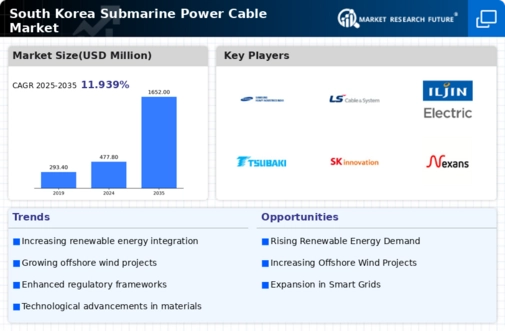Increasing Energy Needs
The growing energy demands in South Korea are driving the submarine power-cable market. As urbanization and industrialization continue to expand, the need for reliable and efficient energy transmission becomes paramount. The country's energy consumption is projected to rise by approximately 2.5% annually, necessitating enhanced infrastructure. Submarine power cables play a crucial role in connecting offshore renewable energy sources, such as wind farms, to the mainland grid. This integration is vital for meeting the increasing energy requirements while ensuring stability in supply. The submarine power-cable market is thus positioned to benefit from this upward trend, as investments in infrastructure are likely to increase to accommodate future energy needs.
Focus on Energy Security
Energy security remains a critical concern for South Korea, influencing the submarine power-cable market. The country relies heavily on imported fossil fuels, making it vulnerable to supply disruptions. To mitigate this risk, South Korea is investing in diverse energy sources, including offshore wind and solar power. The government aims to increase the share of renewable energy in the energy mix to 20% by 2030. Submarine power cables are essential for connecting these renewable sources to the grid, enhancing energy security. The submarine power-cable market is expected to see growth as the government prioritizes projects that bolster energy independence and reliability.
Investment in Offshore Renewable Projects
Investment in offshore renewable energy projects is a significant driver for the submarine power-cable market. South Korea has ambitious plans to expand its offshore wind capacity, targeting 12 GW by 2030. This expansion necessitates the deployment of submarine power cables to transmit generated electricity to the grid. The submarine power-cable market is poised for growth as both public and private sectors invest heavily in these projects. The financial commitment to offshore renewable initiatives indicates a robust market outlook, as the need for efficient energy transmission solutions becomes increasingly critical in achieving national energy goals.
Technological Innovations in Cable Design
Technological advancements in cable design and materials are influencing the submarine power-cable market. Innovations such as improved insulation materials and enhanced cable durability are enabling longer transmission distances and higher capacity. These developments are crucial for connecting remote offshore energy sources to the mainland grid. The submarine power-cable market is likely to benefit from these innovations, as they reduce installation and maintenance costs while increasing efficiency. As technology continues to evolve, the market may see a rise in demand for advanced submarine cables that can withstand harsh marine environments, further driving growth.
Environmental Regulations and Sustainability
The push for sustainability and adherence to environmental regulations are shaping the submarine power-cable market. South Korea has committed to reducing greenhouse gas emissions by 37% by 2030, which necessitates a transition to cleaner energy sources. Submarine power cables facilitate the integration of renewable energy into the grid, aligning with these environmental goals. The market is likely to experience growth as companies seek to comply with stringent regulations while investing in sustainable technologies. This trend indicates a shift towards eco-friendly solutions, where submarine power cables serve as a vital link in the transition to a low-carbon economy.






















Leave a Comment